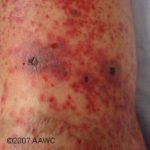Necrotizing Fasciitis – Introduction
Necrotizing fasciitis (NF) is a life-threatening soft tissue infection a condition, often referred to in the press as the ‘flesh-eating bug’ on account of the speed with which the infection spreads. The condition was first described by Hippocrates around the fifth century, and the term “necrotizing fasciitis” was coined by Joseph Jones, a former Confederate…

